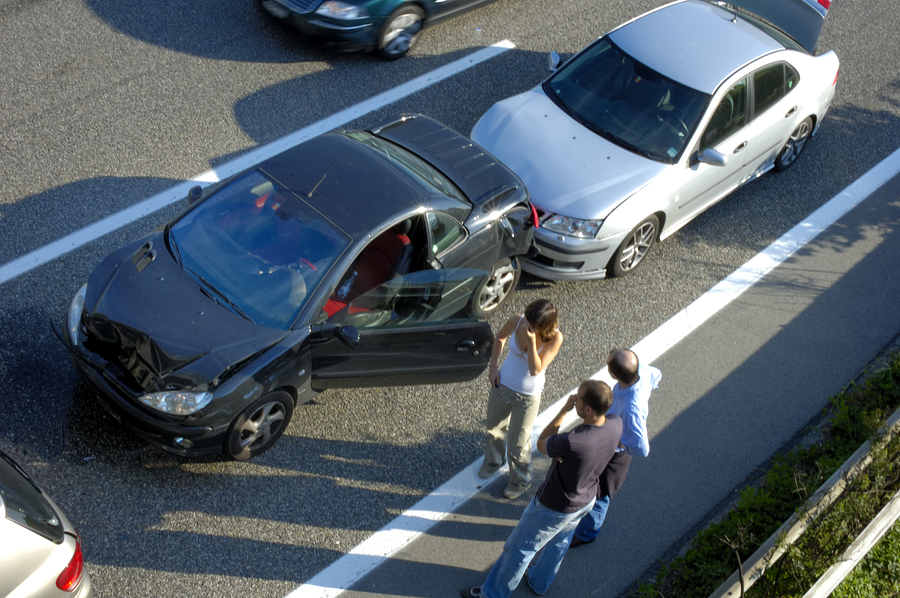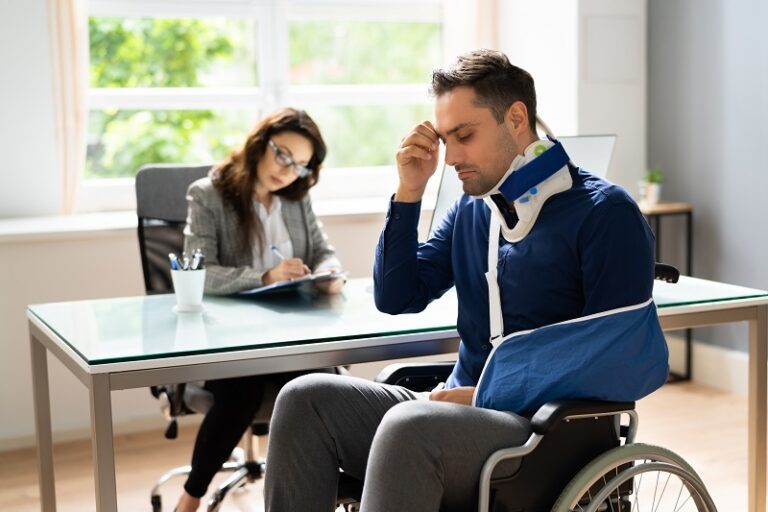Car accidents befall drivers under all sorts of circumstances. Some happen because of factors out of everyone’s control. A tree falls across the road in a high wind just as traffic passes beneath it, for instance. No one bears the blame for these freak accidents. They just happen. Insurance companies sometimes refer to them, in fact, as acts of God.
In our experience as lawyers for victims of motor vehicle collisions, those crashes represent the exception, not the rule. From our perspective, most car accidents result from someone’s dangerous decisions or actions. That someone can be a person, a corporate entity, a government agency, or any combination of them.
Whoever it is, we attorneys for crash victims call that “someone” an “at-fault party” who has a legal liability to our client for financial damages. One of the most important tasks we perform as auto accident lawyers involves identifying every single one of those people for any given car accident, to give our injured client the best possible chance of recovering every dollar of compensation available to pay for the harm done. In this blog post, we delve into how we identify parties at fault, and what we do when we find them.
[lwptoc]
Why Fault Matters
Fault serves as a shorthand for a somewhat broad legal concept. It represents the idea that in day-to-day life, we all have basic legal duties to one another not to conduct ourselves in a way that puts others at an unreasonable risk of harm. Violating that duty—that is, making a decision or doing something that puts others in harm’s way, and thereby injuring them—makes us liable to compensate that person for the harm our decisions or actions caused. The injuries a person suffers, in other words, are our fault, and so, we should pay for them.
That’s a simple enough concept to understand. Putting it into practice, however, often gets quite complicated. Whose fault is a ten-car pile-up, for example? Is it the fault of the first two cars to crash, or of the third that failed to avoid colliding with the wrecks of the first two? Or the fourth? Fifth? And so on.
The law has devised all sorts of methods for answering those questions and the virtually infinite number of others similar to it that arise in car accidents. The goal of all of those methods, however, is to assign blame for an accident as fairly and equitably as possible, to assure all citizens that if something bad happens to them because of someone else’s careless, reckless, or intentionally harmful actions, then they will have a place to go (the courts) to seek just compensation.
So, why does the notion of fault matter? It matters because it serves as the foundation of our community’s ability to right non-criminal wrongs without violence or chaos. It allows us to identify a mistake and apply an appropriate remedy for it.
Finding Fault in a Car Accident
From those lofty principles, let’s now turn to brass tacks. How does someone figure out who has fault for a car accident? This is a question that car accident lawyers spend our lives puzzling-over. The short answer is that no single method for identifying fault exists, at least, not in detail.
However, broadly speaking, finding fault for a car accident almost always involves a process of learning how a crash and its resulting injuries happened, and then exploring the timelines leading up to the moments of impact and harm to pinpoint every action and decision that played enough of a role in the outcome for us to hold the actor or decision-maker accountable.
Simple, right? Not so much. Here is how that process might work in practice.
A Crash, and an Immediate, Initial Investigation
A car crash happens. Drivers and passengers suffer injuries. Assuming everyone involved acts as they should, someone calls 911 and all of the parties stay at the scene. EMTs arrive and triage the injuries, carting away anyone with a health emergency in an ambulance. Police arrive, too, and immediately begin assessing the scene. They have a short window of time in which to interview witnesses, survey the damage, and perhaps take some photographs, before clean-up crews arrive to tow away the vehicles and sweep the road surface of debris.
In all but the most catastrophic accidents, this process happens over the course of an hour or two. When it is over, one of the police officers who responded to the scene writes a report, which contains a standard set of information about the crash: the names, contact information, and statements of everyone involved, a diagram of how the accident appears to have happened, and the officer’s initial conclusions about who was at-fault.
This report holds some weight. It is an official document prepared by an officer with training in assessing accident scenes. It also reflects the earliest evidence gathered about the crash, which often (but not always) gives that evidence some added reliability.
Still, the report does not conclusively decide who has fault for a crash. It represents a starting point, to be sure, but quite often it only scratches the surface of finding fault.
Lawyers and Insurance Investigators Get Involved
Virtually all car accidents receive some attention from insurance companies because virtually all drivers carry auto insurance that covers them and others against costs resulting from a crash. Insurance companies, however, do not make a profit by paying out claims against their policies blindly. Instead, they assign an insurance adjuster to investigate the accident to determine if their insured (the person who bought the policy) was at fault.
If so, then the insurance company may have to pay a claim to compensate the others injured in the accident. If not, then the insurance company does not have to pay those claims. Guess which option the insurance company prefers?
Ideally, at the same time insurance companies start ramping-up their own investigation of the accident, a car accident lawyer for an injured accident victim will also start looking into the details of the crash. Like the insurance company, the car accident lawyer and the injured client have a vested interest in the outcome of the investigation. They do it to look for all parties who may have fault for a crash, because each of those parties may have legal liability to the injured victim for damages.
The investigations these opposing parties perform often delves far deeper into the facts than those covered in the police officer’s initial report. They may re-interview witnesses and re-review accident scene photos. They may track down evidence the police did not think to seek, such as CCTV or dash-cam footage of the crash, or cell phone and GPS records from the drivers involved. They may also retain the services of experts to dig even deeper into the evidence, looking for telltale signs of mechanical failures or other potential causes of a crash.
Dueling Viewpoints Battle It Out
In an ideal world, these various investigations would reach the same conclusions about how the accident happened and whose bad decisions or actions caused it. This, however, is not an ideal world, and in reality, disputes frequently arise about what the evidence shows about who is at fault.
In those cases, reaching a conclusion about fault frequently requires some combination of negotiation and litigation. The car accident lawyer for the injured accident victim negotiates with defense lawyers and insurance representatives to reach an agreement (a settlement) on liability and damages. In litigation (i.e., a lawsuit), the dueling parties take their dispute to the court and, if necessary, present their opposing interpretations of the evidence and of who was at fault for the accident to a judge and jury at a trial.
How to Help Your Car Accident Lawyer Prove Fault
Those who sustain injuries in a car accident sometimes wonder if there is anything they can do to help their car accident lawyer prove fault for the accident. In fact, there is. Here are our suggestions.
Seek Medical Care and Follow the Doctor’s Recommendations
The single most important thing any crash victim can do to help a lawyer identify fault for their accident is to seek appropriate medical care and to follow the doctor’s treatment plan. How does this help a car accident lawyer prove fault? By creating medical records of the injury that tie it directly to a car accident. After all, a car accident lawyer needs to prove not only that a party caused the accident, but also that the accident caused the injured party’s injuries. Seeking and following medical care ensures the lawyer has the most critical evidence necessary to meet the second half of that requirement.
Gather and Preserve Evidence
Car accident victims can also help their attorney prove who was at fault for the crash by gathering and preserving evidence. Ideally, evidence gathering can start immediately after the crash with the victim taking photographs of the accident scene and collecting information from the other drivers and passengers involved. Realistically, many injured accident victims cannot play detective at the scene, because to do so would put their health and safety at risk.
However, even if a crash victim cannot take pictures or videos at the accident scene, the victim can still preserve critical evidence. For example, the victim can take steps to prevent a totaled car from being sent to the junkyard until an auto accident lawyer or lawyer’s expert consultant has a chance to look it over. The victim can also save all insurance, medical, and other records that relate to the accident, instead of throwing them away. These simple steps can ensure the availability of the evidence an auto accident lawyer needs to determine fault.
Beware Insurance Companies
Car accident victims can also help an auto accident lawyer prove fault by not short-circuiting the process of communicating with an insurance company. Here is what we mean.
Sometimes, the insurance company that issued a policy to a party potentially at fault for a car accident may try to contact and interview victims. These are not friendly calls. The insurance company hopes that the victims will say something or reveal some information that lets the insurance company’s customer (and the insurer itself) off-the-hook for paying damages related to the crash. For instance, the insurance adjuster may ask questions aimed at getting the victim to admit partial fault for the collision. These tactics can undermine an attorney’s search for the at-fault party before they even begin.
Similarly, insurance companies may approach a victim and offer a quick settlement of the victim’s claims, before the victim has had an opportunity to speak with an attorney. Victims often need money, and are known to jump at offers from seemingly friendly insurance adjusters. Unfortunately, that is usually a big mistake.
Insurers rarely offer a fair settlement from the get-go, hoping the victim will sacrifice important legal rights to compensation on-the-cheap. So, crash victims should never, ever agree to settle a claim with someone else’s insurance company until they have consulted with an experienced car accident injury attorney about their rights and the amount of money they should receive.
Seek Legal Help Right Away
Finally, car accident victims can help their car accident lawyer prove fault by…making sure they have a car accident lawyer from the outset. This sounds obvious, maybe, but sometimes accident victims put off hiring a lawyer for months or more, thinking they will eventually get around to it and that the delay is no big deal. In fact, in those months, important evidence can go missing, and critical witness memories of the crash can fade.
The most reliable way to make sure a car accident attorney has all of the information necessary to identify who was at fault for an auto accident, and to hold those at-fault parties financially accountable, is to retain an experienced auto accident injury attorney as soon as possible. The sooner a skilled car accident lawyer begins working on a crash victim’s behalf, the better the odds are of that victim recovering maximum compensation.
For information about your legal rights after a car accident, contact an experienced car accident lawyer today.







